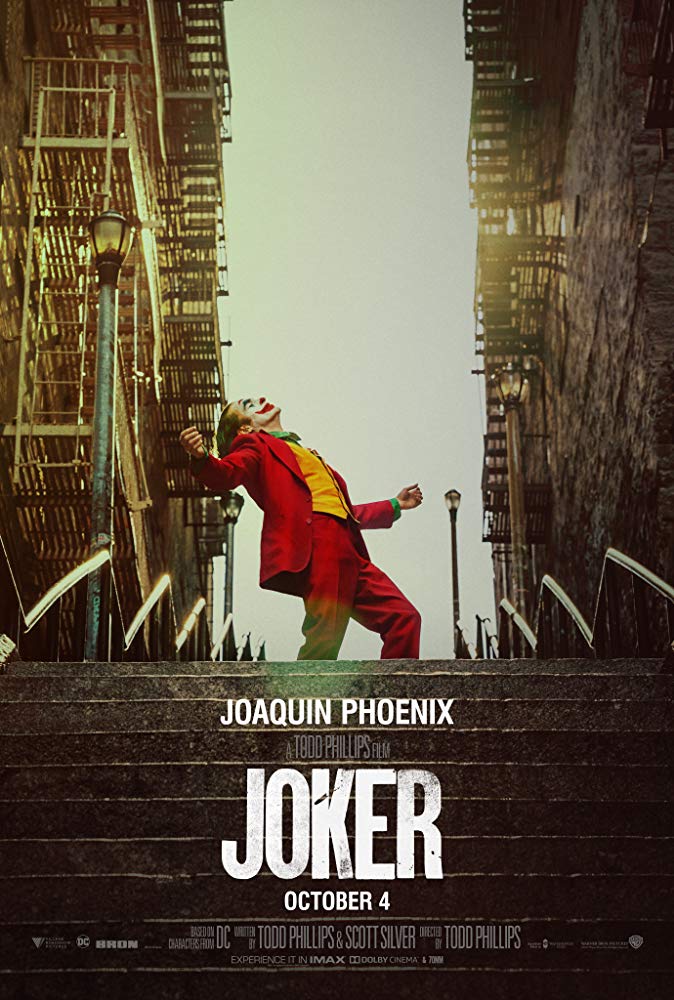|
by Brianna McCray
The movie Joker was released October 4, 2019 and was the subject of a lot of controversy. Quick summary: Joker is about a man named Arthur Fleck who is abused in every possible way, and you, the audience, have a front row seat to his descent into madness. We all know the Joker as the well-known comic book villain in Gotham City who is mentally unwell. But this film takes a turn by showing his downward spiral.
The list of important aspects of mental illness portrayed in this film could go on and on, but I want to focus on a few scenes and topics that grabbed my attention: how mental health services are portrayed, the improvised bathroom scene, the improvised refrigerator scene, and the scene where Arthur is rehearsing for the TV show. (Beware: spoilers ahead!) The film shows the behind the scenes of mental health services, which are on shaky grounds in Gotham City. This runs parallel to the mental health services in the real world that we live in. The fear that races inside one’s mind of “what if I am unable to get my medication” or “what if I lose my healthcare resources, what will happen to me?” is real. These are real fears that twist around in my mind as well. When Arthur tells his social worker “You don’t listen, do you? You ask the same questions every week. How is your job? Are you having any negative thoughts? All I have are negative thoughts,” this is relatable to anyone who lives with any type of mental illness. Arthur also asks his social worker “Is it just me or is it getting crazier out there?” To me, Arthur sounds like he is more aware of the chaos in the world than most of the people in Gotham City. Yes, this could reflect events that are happening in society today. But Corey Chichizola from CinemaBlend says, “Todd Phillips' Joker is one of those movies breaking new ground by being disconnected from the greater shared universe. In fact, the movie's 1981 setting was chosen partly to make this distinction.” This shows that Phillips’ intention was to look back on history and he purposely didn’t focus on today’s events, which begs one question: why not? Why didn’t Phillips focus on today’s events? Perhaps Phillips didn’t want to relate Joker to the world today because there are already many people discussing the events happening. My take is that maybe Phillips is trying to portray that mental illness has been around for years and years, and the problem is not new. The help that people need is still not accessible to them. The scene that stuck with me the most was when Arthur runs into an unclean bathroom after murdering three Wall Street workers who taunt and assault him on the subway. Joaquin Phoenix improvises the scene from the script and begins to dance alone with slow gentle movements to the “Bathroom Dance” music by Hildur Guonadottir. I believe this is an important scene because it beautifully captures how he centers himself in a traumatic event and how he is going further into turmoil. From my personal experience, when I am going through an inner turmoil (negative thoughts about myself) and I am trying to find my center, I will ground myself by focusing on sensations like feeling the ground underneath my feet and focusing on something that is in the real world, much like Arthur centers himself by dancing. The scene ends with Arthur looking at his reflection in the disformed and filthy mirror, which sends a strong message that anyone’s mental health can be distorted by life’s abuse. True, the Joker is mentally mad, but don’t we all have a little dark side that we put in a room and lock the door? Under the right conditions anyone’s locked door could burst open. Phoenix had to get inside the mind of Arthur who at the end of the film identifies as the Joker. With the help of the music in the film, Phoenix was able to show Arthur’s gradual descent into madness. As Mahmoud from CinemaBlend says, “When he climbed in the refrigerator, we had no idea he was going to do that. We set up two camera positions, and Joaquin just thought about what he would do if he was a massive insomniac. Again, we lit it so he could go anywhere, and the first and only time he did it, we were mesmerized. I remember thinking, ‘What is he doing? Did he just crawl in the fridge?’” As one who struggles with mental illness, when I saw the improvised refrigerator scene, I thought to myself, haven’t we all been there when life is just too much and we just want to escape? Phoenix successfully portrays the emotion of being over stimulated from his environment and trying to get away from it all. The final scene that stood out to me, which I had concerns with, was when Arthur was invited on Murray Franklin’s show. First, we see Arthur rehearsing his plan to tell a joke and then take his own life. But instead, live on the air Arthur confesses to the subway killings and says, “What do you get when you cross a mentally ill loner with a society that abandons him and treats him like trash? You get what you (expletive) deserve!” Then Arthur shoots Murray. This scene sends the wrong message that all those that live with mental illness are dangerous. Not everyone who suffers with mental illness will go around hurting others. From my own personal view, those with mental illness are more likely to hurt themselves to either feel pain (to see if they are alive) or to end the pain. Someone who goes around hurting others is pure evil. During this scene you have to remember that you are watching a film about the Joker who is a villain of Gotham City. In closing, when I saw the film, I didn’t feel like it was targeting a specific mental illness, which I greatly appreciate. The film doesn’t give the audience Arthur’s diagnosis, which I believe was a strong and smart decision on Todd Phillips part. Joker is a thought-provoking and important film that will cause you to reflect on society and its ills. I will suggest viewers keep an open mind to this film because if you over think it and question everything that Arthur does or goes through, you will miss the main points. While I do have concerns of how mental illness was portrayed as dangerous, the film is still worth watching. In turning to violence at the end, the film robs those with mental illness of their humanity, which is otherwise shown very well through Arthur’s character. The stigma of mental illness, and our hesitation to talk about it, is the real problem.
0 Comments
Leave a Reply. |
Archives
July 2024
Categories
All
|
|
Glassworks is a publication of Rowan University's Master of Arts in Writing 260 Victoria Street • Glassboro, New Jersey 08028 [email protected] |
All Content on this Site (c) 2024 Glassworks
|


 RSS Feed
RSS Feed
